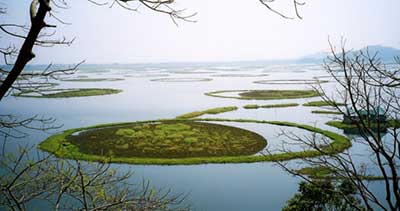Relevance: GS-3: Conservation, environmental pollution and degradation, environmental impact assessment
Key Phrases: Wetlands of international importance, Montreux Record, Ramsar Sites, Sustainable use, Central Asian Flyway, Ecological character, Ecologically sensitive wetlands, Low tide.
Why in News?
- On the eve of the World Wetlands Day, the Ramsar Convention on Wetlands has designated Khijadia Bird Sanctuary near Jamnagar in Gujarat and Bakhira Wildlife Sanctuary in Uttar Pradesh as wetlands of international importance.
- Forest and Wildlife Department officials said India has a network of 49 such sites, the highest in South Asia, covering 10,93,636 hectares.
- Ramsar sites are wetlands of international importance as per UNESCO’s 1971 Convention on Wetlands held in Ramsar, Iran. Officials said the certification brings visibility to ecologically sensitive wetlands and helps in conservation.
Location and list of Ramsar Wetland Sites of India

What is Ramsar Convention:
The Ramsar Convention, which came into existence in 1971, is an intergovernmental treaty that provides the framework for national action and international cooperation for the conservation and wise use of wetlands and their resources.
The Montreux Record:
- The Montreux Record is a register of wetland sites on the
List of Wetlands of International Importance where changes in
ecological character have occurred, are occurring, or are likely to
occur as a result of technological developments, pollution or other
human interference. It is maintained as part of the Ramsar List.
- At present Keoladeo National Park,Rajasthan and Loktak Lake,Manipur are the two Indian sites listed under it.
- In 1993, Chilika Lake was also listed in Montreux Record due to problem of siltation. Later in 2002, it was removed from the list as the problem of siltation was tackled by Govt. of India.
Definition of Wetlands:
- The Ramsar Convention on Wetlands defines wetlands as “areas of marsh, fen, peat land or water, whether natural or artificial, permanent or temporary, with water that is static or flowing, fresh, brackish or salt, including areas of marine water the depth of which at low tide does not exceed six meters.”
- The Indian government’s definition of wetland excludes river channels, paddy fields and other areas where commercial activity takes place.
The Wetlands (Conservation and Management) Rules, 2017 notified by the MoEFCC define wetlands as “area of marsh, fen, peatland or water; whether natural or artificial, permanent or temporary, with water that is static or flowing, fresh, brackish or salt, including areas of marine water the depth of which at low tide does not exceed six meters, but does not include river channels, paddy fields, human-made water bodies/ tanks specifically constructed for drinking water purposes and structures specifically constructed for aquaculture, salt production, recreation and irrigation purposes.”
Wetlands distribution in India:
Globally, wetlands cover 6.4 per cent of the geographical area of the world. In India, according to the National Wetland Inventory and Assessment compiled by the Indian Space Research Organisation (ISRO), wetlands are spread over 1,52,600 square kilometres (sq km) which is 4.63 per cent of the total geographical area of the country.
- Inland-natural wetlands account for 43.4% and coastal-natural wetlands 24.3%.
- India has 19 types of wetlands. In state-wise distribution of wetlands,
Gujarat is at the top with 34,700 sq km (17.56 percent of total geographical
area of the state), or 22.7 percent of total wetlands areas of the country
thanks to a long coastline.
- It is followed by Andhra Pradesh (14,500 sq km), Uttar Pradesh (12,400 sq km) and West Bengal (11,100 sq km
- India’s tally of 49 designated wetlands spread over 10,936 sq km in 18 states and two Union Territories is the largest network of Ramsar Sites in South Asia.
- Of the 49 sites, 10 are in UP, 6 in Punjab, 4 each in Gujarat and Jammu and Kashmir, 3 each in Himachal Pradesh and Kerala and rest in others
- The countries with the most Ramsar Sites are the United Kingdom (175) and Mexico (142), as per the Ramsar List.
Significance of Ramsar listing:
- It provides for national action and international cooperation regarding the conservation of wetlands, and wise sustainable use of their resources.
- Standardizing management: Designating a wetland as wetland of global importance may not lead to any extra funding by the global body. But from the management point of view, it is like an accreditation. It is like an ISO certification.
- Improving regulation and conservation: A Ramsar tag makes it incumbent upon authority to strengthen the protection regime there and also creates defences against encroachment etc on wetlands.
- Habitat of Migratory birds: The Central Asian Flyway (CAF) is one of the nine global waterbird flyways; nearly 71% of the migratory waterbirds of the CAF use India as a stopover site. Sustaining the health of India’s wetlands is thus crucial for maintaining the waterbird populations within the flyway.
Wetlands also have a deep connection with Indian culture and traditions. Loktak Lake in Manipur is revered as “Ima” (Mother) by locals, whereas Sikkim’s Khecheopalri Lake is popular as the “wish fulfilling lake”. Due to their huge importance the Government of India accords high significance to wetlands conservation and seeks to mainstream its full range of values at all levels of developmental planning and decision-making.
Sources: Indian Express
Mains Question:
Q. What are Ramsar Sites, and what is the significance of this listing? Explaining the threats persisting to wetlands suggest measures for its conservation. [250 words]









